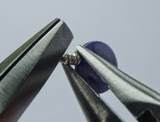Yep I've been making some headpins.
I love making headpins, I wasn't sure how to make them in the beginning as I didn't know the best way to hold the wire while I added the glass. So I chatted to a few fellow lampworker friends and came up with using scrap wire and wrapping them onto a mandrel with it.
This works really well but is a bit time consuming getting them prepared. I saw Linda from Earthshine Beads on fb showing a photo of her demoing at a show at the weekend and she was using a pin vice to hold the wire. I think I might try it out and see how that goes! So thank you to Linda for that idea, very helpful.
Dark Multicolour glass by Riechenbach
I love this glass one of my favourites at the moment, made by Riechenbach Dark Multi is a reactive glass but it just reacts in the flame with not much or no effort at all really, it just does what it does, just like MAGIC!!
Right then, I made drop headpins first the browny/red ones at the top, then I made the bluey, greeny, purpley ones next (Yes it really is the same glass) then I made the leaves at the very top of the above photo and they had more greens in them, with some brown and purples too. In the first photo at the top of this post you can see some ivory beads and these have some d.multi dots and trails on them.
Now I went off to this years Flame-off in Uttoxeter a couple of weeks ago, had a great time because it is a lampworkers convention which happens once a year (not often enough). It is an event for glass beadmakers hosting demos, supplies, beadmakers selling their own beads and the torch area, so we can get our fix if necessary and beginners can try out torches and have a go at making a bead or two possibly for the first time! I took a turn at helping out on the torches this year and really enjoyed helping some complete beginners make their first bead and a few others who needed some help with how to control the glass and even reshaping a bead for a lovely lady called Beryl. It was such fun I may do it again next year. Some of the demos were fabulous and I did end up buying a few 'keepers' from some of the many artists there!
I stocked up on many different things but of course I couldn't come away without buying some lovely glass!! Oh boy was there some lovely, gorgeous and definitely delicious glass.
CIM glass is my favourite glassmakers and they have some lovely new colours, below is one of them but its not quite come out a very good colour likeness. It still looks gorgeous but I will try and get a better photo tomorrow. Sadly both of these headpins have cracked. I don't think I got them into the bubbles quick enough as well as I may have pushed them to far into the bubbles and maybe they were touching the side of the bowl. I always batch anneal my headpins as I always put them on the bottom of the kiln floor, instead of putting them into the kiln while I am making them.
CIM Poseidon
Must make some more as I love this new colour, which the name escapes me right now!!!
Updated above ....
There are some lovely new oranges, pinks, lilac and all with great names for them as well. Sunset, Frangipan (pink), Alleycat (orangey/yellow), Trade Winds (very dark blue), Gypsy (very dark purple), Rudolph (red), just to name a few!
So lots of making to do and some photos to take as well.
I will see you again very soon.
E x
Updated with names! 8.5.14






















